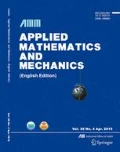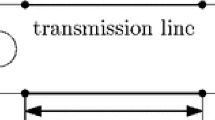Abstract
Based on the principle of virtual work, an updated Lagrangian finite element formulation for the geometrical large deformation analysis of galloping of the iced conductor in an overhead transmission line is developed. In numerical simulation, a threenode isoparametric cable element with three translational and one torsional degrees-offreedom at each node is used to discretize the transmission line. The nonlinear dynamic system equation is solved with the Newmark time integration method and the Newton-Raphson nonlinear iteration. Numerical examples demonstrate the efficiency of the presented method and the developed finite element program. A new possible galloping mode, which may reflect the saturation phenomenon of a nonlinear dynamic system, is discovered under the condition that the lowest order of vertical natural frequency of the transmission line is approximately two times of the horizontal one.
Similar content being viewed by others
Reference
Den Hartog, J. P. Transmission line vibration due to sleet. Transaction AIEE 51, Part 4, 1074–1086 (1932)
Nigol, O. and Clarke, G. J. Conductor galloping and control based on torsional mechanism. IEEE Power Engineering Society, Meeting, Paper No. C74016-2, New York (1974)
Simpson, A. Determination of the natural frequencies of multiconductor overhead transmission lines. Journal of Sound and Vibration 20, 417–449 (1974)
Yu, P., Desai, Y. M., Shah, A. H. et al. Three-degree-of-freedom model for galloping, part I: formulation. Journal of Engineering Mechanics 119(20), 2404–2425 (1993)
Desai, Y. M., Yu, P., Popplewell, N., and Shah, A. H. Finite element modeling of transmission line galloping. Computers & Structures 57(3), 407–420 (1995)
He, Z. and Qian, T. H. The computation of overhead and iced multiconductor galloping with torsional mechanism (in Chinese). Journal of Huazhong University of Science and Technology 26(10), 16–18 (1998)
Wang, L. X., Yang, W. B., Yang, X. H., and Yuan, J. J. Finite element analysis for galloping of transmission lines (in Chinese). Journal of Huazhong University of Science and Technology (Urban Science Edition) 21(1), 76–80 (2004)
Wang, X. C. Finite Element Method (in Chinese), Tsinghua University Press, Beijing (2003)
Veletsos, A. S. and Darbre, G. R. Dynamic stiffness of parabolic cables. International Journal of Earthquake Engineering and Structural Dynamics 11(3), 67–401 (1983)
Barbieri, N., Honorato de Souza Junior O., and Barbieri, R. Dynamical analysis of transmission line cables, part 2—damping estimation. Mechanical System and Sign Process 18, 671–681 (2004)
Edwards, A. T. and Madeyski, A. Progress report on the investigation of galloping of transmission line conductors. AIEE Transaction Distribution, Winter Meeting, New York, 666–686 (1956)
Author information
Authors and Affiliations
Corresponding author
Additional information
(Communicated by Shan-lin CHEN)
Project supported by the Science Foundation of the State Grid Corporation of China (No. 2007-1-77) and the Natural Science Foundation Project of CQ CSTC of China (No. 2006BB6149)
Rights and permissions
About this article
Cite this article
Liu, Xh., Yan, B., Zhang, Hy. et al. Nonlinear numerical simulation method for galloping of iced conductor. Appl. Math. Mech.-Engl. Ed. 30, 489–501 (2009). https://doi.org/10.1007/s10483-009-0409-x
Received:
Revised:
Published:
Issue Date:
DOI: https://doi.org/10.1007/s10483-009-0409-x



